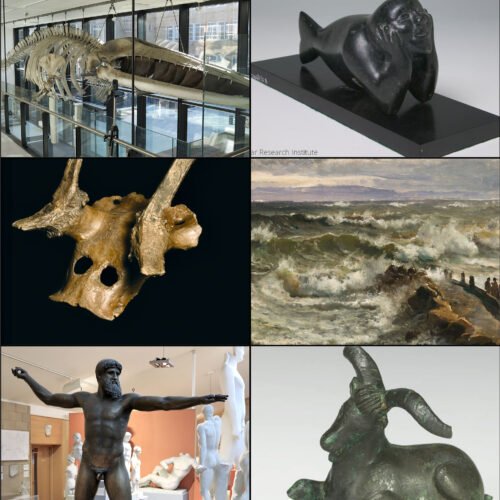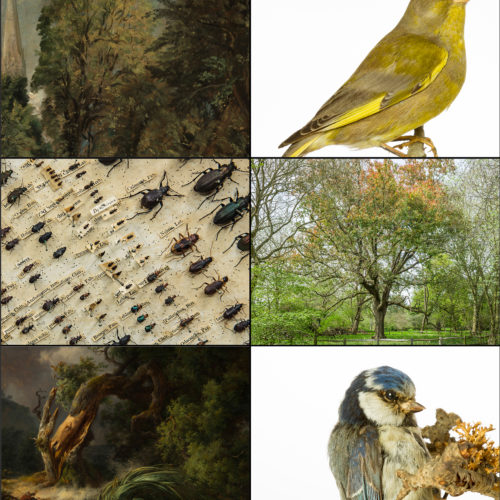Bring the wonder of the University of Cambridge Museums and Botanic Gardens into your classroom to explore the natural world around you and connect creatively with nature.
Inspire Nature is a teacher CPD programme created and delivered by the university museums and garden. A suite of resources have been created for teachers around the themes of Water, Rocks, Viewpoints, Trees and Skies.
Each set of resources focuses on relevant objects from the collections. The resources include high resolution images, information, videos, question prompts and activity ideas for yourself and your teaching, created by both museum educators and artists.
This page highlights the resources created for the Viewpoints and Perspectives theme. It focusses on objects in the Fitzwilliam Museum collection, but our padlet below shows resources relating to the images above, including a bark cloth painting and a navigation chart from the Museum of Anthropology and Archaeology, a children’s jigsaw globe from the Whipple Museum of the History of Science and a large glass lens from the Kettle’s Yard.

Despite his ‘surname’, which means ‘the Venetian,’ from Venice, Italy, Domenico Veneziano was one of the great innovators of Florentine painting, paintings made in Florence, Italy. This is one section of Veneziano’s signed altarpiece, which once hung on the high altar of the church of Santa Lucia de’ Magnoli in Florence and is now in the Uffizi gallery. It was probably painted around 1445, over 500 years ago. The full Altarpiece is believed to be the first painting of the Virgin and Child with saints that were the same size and sharing the same space in the picture.
The painting is an excellent example of the use of linear perspective – recreating a three dimensional world on a two dimensional surface to the correct scale. Close inspection reveals interesting clues about Veneziano’s technique. Incised grid lines on the surface of the picture clearly show how he planned the composition. There is a tiny pin–prick visible in the exact centre of the picture, where the bottom of the upper panels of the garden door meet. This is the vanishing point, the spot upon which all the lines of perspective join.
Although the altarpiece has been separated and distributed between different museum collections around the world, we know the main panel depicts The Virgin and Child on a throne between St Francis and St John the Baptist, St Zenobius and St Lucy. The predella, are smaller pictures that run along the bottom of the alterpiece and consisted of five panels, each representing a scene from the life of the saint under which it was situated. Before the altarpiece was dismantled, you would have been able to follow the pointing finger of the Archangel Gabriel, up to the figure of the Christ Child on the Virgin’s knee, to draw attention to the chief focus of the altar: Christ.
This painting is the central section of the five predella panels and tells the story of the annunciation. Archangel Gabriel is announcing to Mary that she is to bear the son of God. There are many symbolic elements that have been included as a visual clues to emphasise Mary’s virginity:
- All linear perspective points converge upon a bolted door that encloses the garden in the background.
- Mary crosses her arms over her chest, with a bashful downturn of her head.
- She has a discreet, elliptical halo.
- The white lilies that the archangel Gabriel offers Mary symbolise the purity of the Virgin
and stresses the sanctity of the event.
The Annunciation by Domenico Veneziano
- Can you tell how old this painting is from looking at it? What clues are there that it is so old? What things have not changed over time?
- What do you think is happening in this painting? Put yourself in the woman’s shoes. How would you be feeling?
- How do you think Veneziano planned this painting to make sure everything was the right size and would fit in? How do you plan your own drawings?
The Annunciation by Domenico Veneziano
- Experiment with transforming pictures in scale using a grid. How do things look really big or small? Can groups create a picture in pieces at the right scale and piece it back together again?
- This painting was created before we had paint in tubes with Egg tempera ( mixing pigment colour with egg yolk to make paint). Explore mixing colours with this medium and how it feels on different surfaces.
- Can you make paint with any other natural materials you can find?
- Symbols and colours are used to tell us what is happening and about Mary’s character, what colour, object and place would you choose to tell us something about you?






